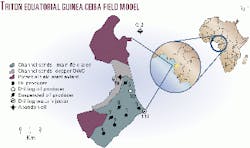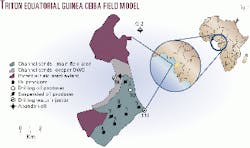Reserves growing at Ceiba field off Equatorial Guinea
The first field found in the Rio Muni basin off Equatorial Guinea is large and growing larger.
A deeper pool discovery and other recent drilling at Ceiba field off central Africa's west coast extended the field to the northwest and increased its reserves, partly from a known zone that previously was not expected to contribute significant volumes of oil.
Four wells averaged a combined 45,000 b/d of 30° gravity oil in early April, up from 42,000 b/d in March. The field on Block G went on line Nov. 22, 2000, 14 months after discovery (OGJ, Mar. 26, 2001, p. 30).
Based on the most recent drilling results, Triton is refining its field geologic model to redetermine reservoir thickness, quality, and extent in the main pool, said James Musselman, president and CEO.
"Both Ceiba 8 and 9 have shown us that our acreage on blocks F and G clearly holds sizable upside surprises, so we are re-evaluating it based on the very encouraging results of these wells," Musselman said.
Working interests in the field and two blocks, which total about 1 million acres, are Triton 85% and Energy Africa Ltd., Cape Town, 15%.
Unexpected results
The Ceiba 9 well, planned as a water injector, found 174 ft of net oil pay. It will extend known field limits to the west and northwest, significantly increasing gross reserves from the 2000 yearend estimate of 113 million bbl, Triton said.
Ceiba 9's oil-water contact was 374 ft deeper than the OWC on the field's south flank.
Ceiba 8, the field's best well so far in terms of pay thickness, had 413 ft of net oil pay, including 98 ft in a deeper pool not seen in any previous well. Pressure in the new pool is 400 psi higher than that in the primary Ceiba oil reservoir. Pressure measurements at Ceiba 8 confirmed reservoir connectivity, Triton said.
Ceiba 8 was drilled in the central part of the Ceiba structure in an area previously thought to have uncertain reservoir potential. More drilling is needed to determine the new pool's potential.
Ceiba 7 is the first well completed in the field's laminated sand facies, from which Triton had booked no reserves at yearend. The laminated sands have good deliverability and reservoir continuity and connectivity and can now be expected to make an important contribution to reserves, Musselman said.
Ceiba 7 is the field's first well to be completed with an open-hole gravel pack to enhance oil deliverability from the laminated sands.
Drilling programs
Triton said discovery of the deeper OWC at Ceiba 9 and revised seismic calibration data provided the company with the technical basis for a new geologic model for the field and that the data also have positive implications for nearby exploration prospects to be drilled this year.
After reviewing exploration prospects and reassessing its exploration strategy on blocks F and G, the company plans to resume exploratory drilling. It is to spud the G-5 well, location being finalized, on Block G in May.
The current development plan calls for drilling and completion of 10 producing wells and four water injectors by early 2002.
The plan includes sidetracking Ceiba 9 downdip as a water injector to maintain reservoir pressure and enhance oil recovery.
The Global Marine R.F. Bauer drillship and the Sedco 700 semisubmersible are working in Ceiba field.
The first five wells were in 2,165-2,621 ft of water in the Gulf of Guinea 22 miles off Bata on the Rio Muni coast.

